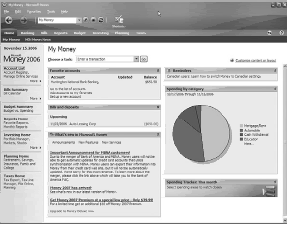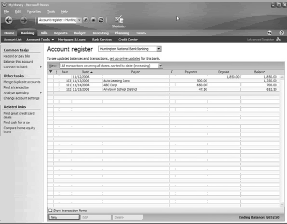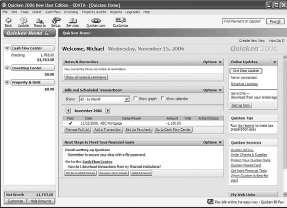Microsoft Money and Quicken
Most new computers come with at least one personal finance program installed. That program might be Microsoft Money, or it might be Intuit’s Quicken. You can use either of these programs to manage your household budgets, track your bank accounts and investments, write checks, and even pay your bills online.
In addition, most banks and credit card companies let you manage all your financial accounts online, from their own websites. You don’t have to install any software to do this; just access the bank’s website with Internet Explorer and do your banking from within your web browser.
Managing Money with Microsoft Money
The personal finance program included with most new PCs (and with Microsoft Works Suite) is Microsoft Money. This program lets you manage all your bank transactions, balance your checkbook, and pay bills online.
Setting Up Your Accounts
Before you can use Microsoft Money, you have to configure it with information about your specific banking and financial accounts. The first time you start the program, Money asks you a series of questions to help you set up the program for your own financial accounts.
You’ll need to supply your Microsoft Passport information (typically your Hotmail address), as well as information about all your banking and credit card accounts (including financial institution and account number). Obviously, it’s easier if you gather this information ahead of time, so you can breeze through the initial setup.
Navigating Money
Before you start working with your accounts, it’s a good idea to get familiar with the way Money works—starting from the My Money Home page, shown in Figure 1. This page is your “home base” for all your Money-related transactions and includes links to different activities; you click a link to access that activity.
Across the top of the My Money Home page are buttons that link to Money’s other financial centers. These pages organize tasks and information by specific types of activity. The buttons across the top of the My Money Home page take you directly to these financial centers:
- Home—Takes you back to the My Money Home page, from anywhere in the program.
- Banking—Display your account list (for both banking and investment accounts); you can view account balances, add new accounts, manage existing accounts, and link directly to each account’s register.
- Bills—Set up new payees, pay bills, and register deposits to your banking accounts.
- Reports—Create a variety of reports and charts.
- Budget—Access Money’s Budget Planner, which lets you create a budget, create a debt reduction plan, and plan your 401(k).
- Investing—View and edit your investment portfolio, record new investment transactions, and go online to get current stock quotes.
- Planning—Plan for various financial scenarios, including retirement, college, savings, and so forth.
- Taxes—Plan and prepare your taxes online.
Managing Bank Account
Many people use Microsoft Money to track their banking transactions. You can enter transactions manually—or, if you’re connected to the Internet, download transactions electronically from your banking institution.
To enter a transaction manually, go to the Banking page and click the link for your bank account. This displays that account’s register, as shown in Figure 2; from here you click the New button to enter a new withdrawal (including bill payments), deposit, or transfer between accounts.
Quick and Easy Banking with Quicken
Like Microsoft Money, Quicken is a financial management program that lets you manage all your banking and investment activities. Quicken has actually been around longer than Money and has a larger user base.
If you have a new PC, chances are you have Quicken New User edition already installed; other, more fully featured editions are also available.
Setting Up Your Accounts
Before you can use Quicken, you have to set up the program to recognize all your bank and financial accounts. This is typically done by following the steps in the wizard that appears when you first start the program; you can also add new accounts at any time by selecting File, New, and then choosing the New Quicken Account option.
To setup Quicken to manage your finances, you must have information about all your financial accounts—bank accounts, credit card accounts, investment accounts, and so on. The best way to do this is to gather the most recent statements for all these accounts before you start so that you’ll have all the account numbers handy.
Navigating Quicken
The Quicken Home page, shown in Figure 3, offers a wealth of information. The main area of the workspace displays a variety of key data about your financial accounts and transactions—including any upcoming bills and scheduled transactions. Click any item to view more detail.
Your key accounts are listed in the sidebar at the left side of the workspace; click any account name to view the register for that account. Along the top of the page is a toolbar that provides pushbutton access to key operations and functions.
Managing Your Bank Account
You perform most financial transactions from the register for a particular account. For example, to write checks and note deposits, open your checking account register by clicking the account name on the Home page. When the register appears, you enter transactions directly into the register, or use the menu options to write checks, transfer funds, or reconcile your account.
Doing Online Banking
Both Microsoft Money and Quicken offer the option of online banking. You can set them up to automatically download transactions from your bank and other key accounts, and to pay your bills electronically. All you have to do is supply your account and login information within the program, and then use the online update feature to download your latest transactions.
Of course, you don’t have to use Money or Quicken to do your banking online. Most banks and credit card institutions let you access and manage your account information online, via their own proprietary websites.
All you have to do is register with the website (you’ll need your account number, PIN, and other personal information), and then you can access your account from any web browser. To find out whether your bank or credit card company offers online banking—and to get the website URL—contact your financial institution.
Most are eager to move your banking online because it costs them less money than dealing with a physical paper trail. Some banks charge a slight fee to access their online banking services; others offer online access for free. As always, shop around for the best deal.


